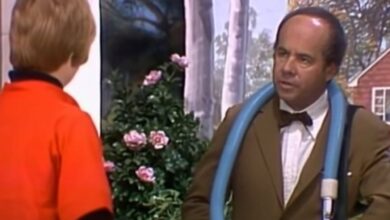George Jones’ “She Thinks I Still Care” Sets a New Standard for Country Heartache in 1962
When George Jones released “She Thinks I Still Care” in April 1962, he unknowingly recorded what would become one of the defining heartbreak anthems of country music. With its understated pain and conversational sorrow, the song climbed to No. 1 on the Billboard Hot Country Songs chart and remained there for six weeks. More than just a hit, it cemented Jones as the genre’s leading voice in expressing quiet devastation. The tune resonated deeply with a postwar generation navigating love, pride, and loss—and it has never left the conversation since.
Born in Saratoga, Texas, in 1931, George Jones grew up immersed in gospel and country music. By the time he began recording in the 1950s, his voice already carried a world-weary richness well beyond his years. Known early in his career for upbeat honky-tonk numbers like “White Lightning,” Jones was increasingly turning toward ballads by the early ’60s. His phrasing, uniquely delicate yet unshakably strong, allowed him to inhabit songs in a way few others could. “She Thinks I Still Care” would be the moment when everything he’d learned about heartache and restraint came into full bloom.
The song was written by Dickey Lee and Steve Duffy, two relatively unknown songwriters at the time. Lee had originally envisioned it as a fast, rockabilly-style tune, but Jones—hearing the demo—slowed it down and transformed it into something haunting and deeply intimate. Legend has it that when producer Pappy Daily brought the song to Jones, he recognized its potential immediately. Rather than play it slick, Jones made the song ache. His delivery turned the narrator’s feigned indifference into a barely concealed breakdown, wrapped in pride and denial.
Recorded at United Recording Studios in Nashville, the session was minimal but effective. Pappy Daily kept the arrangement sparse: a soft acoustic rhythm guitar, steel guitar weeping gently in the background, and a vocal that stood front and center. The key to the song’s emotional power lies in Jones’ phrasing—hesitations, dips, and his almost conversational lilt. He wasn’t just singing the words; he was living them. That sense of emotional nakedness gave the song its staying power and made it a standout even in a decade brimming with country classics.
Upon its release, “She Thinks I Still Care” was met with critical and commercial acclaim. It not only topped the country charts but also stayed there longer than any of his previous singles. DJs played it nonstop. Fans called in requesting it. Its universal message—of pretending not to care when your heart is breaking—struck a chord that went well beyond country audiences. While it never crossed fully into the pop charts, its influence bled across genres. It was praised for its emotional honesty at a time when many country hits leaned into novelty or bravado.
Culturally, the song landed at a pivotal moment. America in 1962 was balancing prosperity with the unease of Cold War tension, and music served as both a comfort and a mirror. In “She Thinks I Still Care,” listeners found a quiet confession of emotional vulnerability, something rarely expressed so plainly. The song subtly challenged the macho norms of the era, showing that a man could hurt deeply and still keep his dignity. It became a cornerstone of what country music could achieve: emotional truth without theatrics.
For George Jones, the song marked a turning point. Already respected, he now became revered. It opened the door to a string of emotionally rich ballads throughout the 1960s and ’70s, such as “The Grand Tour” and “A Good Year for the Roses.” “She Thinks I Still Care” helped shift his image from a honky-tonk hitmaker to the voice of American heartbreak. It would be the song most closely associated with him until he recorded “He Stopped Loving Her Today” nearly two decades later.
The song also shaped the trajectory of country music itself. It showed that subtlety could be just as powerful as bombast. Artists like Merle Haggard, Alan Jackson, and Randy Travis would later cite George Jones—and this song in particular—as a guiding light in crafting emotionally resonant, vocally driven country ballads. It didn’t just influence a style; it validated an entire mode of expression in the genre.
“She Thinks I Still Care” has been covered extensively, a testament to its timeless structure and lyric. Elvis Presley recorded a version in 1977 that leaned into Southern soul. Anne Murray gave it a soft, pop-country twist in 1974, earning a top-five country hit herself. But none match the raw ache of the original. Every cover inevitably draws comparisons to Jones’ unmatched ability to say so much with so little.
At the time of the song’s release, Jones was going through a period of personal turbulence—his first marriage had ended, and his relationship with alcohol was beginning to take hold. The pain he poured into the vocal wasn’t just performance; it was autobiographical. That edge of lived experience gave the song even more depth, something listeners sensed even if they didn’t know the details.
Over the decades, the song has become a standard. It appears on nearly every “Best of George Jones” compilation, and it remains a staple of classic country radio. Younger generations continue to discover it, drawn to its emotional clarity and poetic simplicity. It’s one of those rare songs that requires no context—it speaks to the universal experience of heartbreak and the masks we wear to hide it.
Musically, it helped push country music toward more mature themes, opening the door for greater emotional complexity. In a way, it served as a prototype for future slow burns—songs that don’t demand attention but earn it. Its production style also influenced a return to minimalism in country arrangements, a trend that would come and go but never fully disappear.
In later years, as Jones struggled with addiction and public scrutiny, “She Thinks I Still Care” remained a reminder of his brilliance. It wasn’t tied to scandal or excess—it was tied to truth. And when he passed away in 2013, tributes poured in not just for “He Stopped Loving Her Today,” but for this quieter classic that had launched a legend.
Ultimately, “She Thinks I Still Care” stands as one of country music’s purest expressions of regret and pride tangled together. It elevated George Jones from a successful singer to a storytelling icon. And more than half a century later, the song still lingers—familiar, haunting, and honest as ever.





